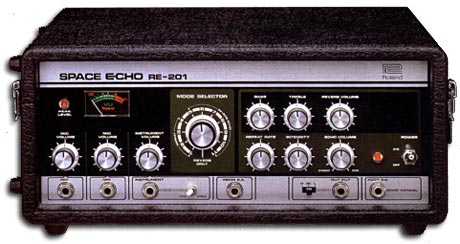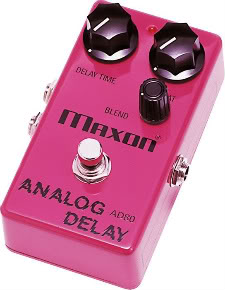Delay Processors
In it’s simplest form, a delay is made up of very few components.An audio input, a recording device, a playback device and an audio output.
Tape Delay
Early delay processors, such as the Echosonic, Echoplex and the Roland Space Echo, were based on analog tape technology. They used magnetic tape as the recording and playback medium. Some of these devices adjusted delay time by adjusting the distance between the playback and record heads, and others used fixed heads and adjustable tape speed.Analog Delay
Analog delay processors became available in the 70s and used solid state electronics as an alternative to the tape delay.Digital Delay
In the late 70s, inexpensive digital technology led to the first digital delays.Digital delay systems function by sampling the input signal through an analog-to-digital converter, after which the signal is recorded into a storage buffer, and then plays back the stored audio based on parameters set by the user. The delayed (“wet”) output may be mixed with the unmodified (“dry”) at the output.
Software Delay
These days you’ll most likely be using plugins for your delay processing, same principles, just without the moving parts, additionally, they can sound pretty close to any of the other styles or be totally unique like OhmBoyz below.Effect Parameters
Delay Time> how long before the sound is repeatedTempo Sync> each repeat of the delay will be in time with the song, ¼ notes or 1/8 notes
Tap tempo> tap this button along with the song to set the delay time
Feedback> output is routed back to input for additional repeats
Mix/Wet-Dry> mix of original signal with delayed signal
Rate> LFO rate to change delay time
Depth> range of delay time change for LFO
Filter> usually a high cut filter, each repeat gets darker sounding
Stereo delays often have separate Left and Right controls.
What does it do?
Now, what sort of sounds can we get with delay processors.An automatic double tracking effect can be accomplished by taking a mono signal, run it into a stereo delay, have no processing on the left side, and a very short delay on the right side.
Have a listen [double-track.mp3]
A slap back or slapdelay has a longer delay time from about 75 to 200 milliseconds. This is the sort of delay was a characteristic of the 50′s rock n roll records.
Here it is on some guitar [slapback.mp3]
A ping pong delay uses two separate delay processors that feed into each other. First the dry signal is heard, the signal is sent to the left side, this delayed signal is sent to the right side, and the right side is sent back to the left.
Chorus, flanging and phasing can all be created with delays as well. A post on modulation effects is coming soon.
Some tips on using delays
On vocals try using a short delay instead of reverb, sometimes it works better.Set up a ping pong delay after a large reverb so the reverb seems to get steadily wider.
The last tip I have is be careful with that feedback control, things can get very loud, very quickly.




No comments:
Post a Comment